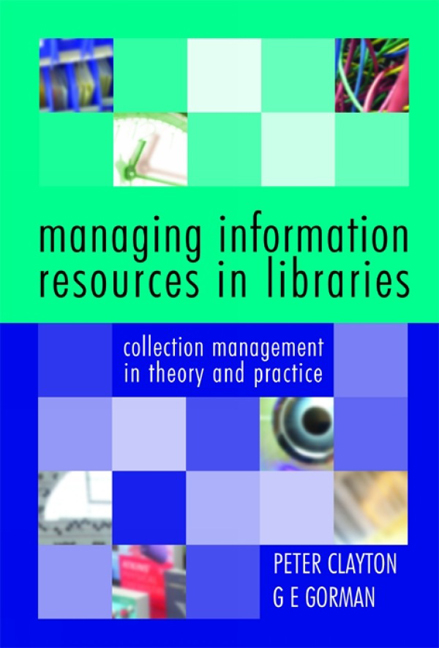Book contents
- Frontmatter
- Contents
- About the authors
- Preface
- 1 Managing information resources in context
- 2 Collection management and collection development policies
- 3 Conspectus
- 4 Resource sharing and co-operative collection development
- 5 Selection: policies and procedures
- 6 Selection resources
- 7 Acquisitions processes and procedures
- 8 Budget management
- 9 Collection evaluation and review
- 10 Preservation and weeding
- The literature of collection management Adela Clayton
- Index
7 - Acquisitions processes and procedures
Published online by Cambridge University Press: 08 June 2018
- Frontmatter
- Contents
- About the authors
- Preface
- 1 Managing information resources in context
- 2 Collection management and collection development policies
- 3 Conspectus
- 4 Resource sharing and co-operative collection development
- 5 Selection: policies and procedures
- 6 Selection resources
- 7 Acquisitions processes and procedures
- 8 Budget management
- 9 Collection evaluation and review
- 10 Preservation and weeding
- The literature of collection management Adela Clayton
- Index
Summary
Focus questions
• Why do most larger libraries acquire material from library suppliers rather than bookshops or publishers?
• How should a library choose and evaluate suppliers?
• What are some of the difficulties in acquiring serials?
• What are the particular difficulties associated with electronic media and licensing?
• How should a library go about processing gift and exchange material?
• How can a library acquire material that is out of print?
In the preface to this volume, we defined acquisitions as the employment of a range of methods to provide access to the information required by readers. The basic principles of acquisitions are straightforward enough: a library needs to set up procedures to obtain this information as economically and as quickly as possible. Once established, these procedures are usually executed by support staff, under only the general direction of professionals. However, the establishment and ongoing modification of these procedures, and the choices and decisions they embody, are high level professional tasks that merit consideration here.
Choice of supplier
For many years, almost all larger libraries have effectively outsourced much of the work of acquiring information resources for their collections to library supply firms, or vendors (called ‘jobbers’ in the USA). There are in fact many ways of acquiring material, and in some circumstances each one of them may be most appropriate.
Bookshops or travelling salespeople can be the most convenient, having the advantage (especially important for school and children's libraries) that you can examine a title before deciding whether to buy it – and, of course, every title you see is available, and with a known price. In addition, there are sometimes good political reasons for a library, such as a public library, to purchase at least some material locally. Against these advantages, buying from local bookshops or visiting booksellers is undoubtedly more expensive, and the range of stock is inevitably quite limited.
Online booksellers, such as Amazon.com, can be equally if not more convenient than high-street bookshops. Their databases often provide a range of ‘valueadded’ information, such as publishers’ blurbs, published reviews and even reviews contributed by customers; can be kept very up to date; and ordering is certainly easy.
- Type
- Chapter
- Information
- Managing Information Resources in LibrariesCollection Management in Theory and Practice, pp. 118 - 139Publisher: FacetPrint publication year: 2006



